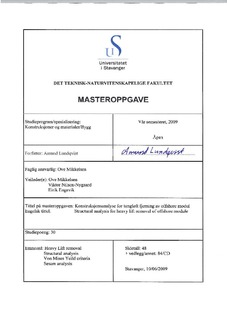| dc.contributor.author | Lundqvist, Amund | |
| dc.date.accessioned | 2009-10-13T15:59:43Z | |
| dc.date.issued | 2009 | |
| dc.identifier.uri | http://hdl.handle.net/11250/182688 | |
| dc.description | Master's thesis in Structural engineering | en |
| dc.description.abstract | This report presents a study of the structural analysis for removal operation of the Frigg
TCP2 M32 Module with a new lifting arrangement situated at the top of the M32
Module.
During the removal of the M32 from the Frigg TCP2 platform performed in 2005 a
planned delay to the lifting operations was required, due to installation and welding of the
M32 module lifting points at the bottom frame of the module. The intention of this study
is to investigate if the interruption could have been avoided. This is done by performing
structural analysis and verification of the M32 Module and the feasibility of installing
padeyes at the top of the M32 Module. Global and local analysis covers the ultimate limit
state and is carried out in accordance with prevailing design rules and standards.
The global analyses are performed by using the Sesam software package and local
analysis are performed by a combination of finite element analysis, analytical stress
analysis and code checks.
The lifting operation is defined as a heavy lift operation. Data from the Saipem S7000
semi-submergible crane vessel is used for defining load input for lifting and
transportation of the M32 module. In this study the lifting arrangement is defined as a
single crane lift with 3 loose spreader bars.
The first global analysis showed failure of columns connected to the lifting points. To
maintain the structural integrity of the module during lifting, these columns were
reinforced by adding reinforcement plates to the failing structural elements.
After that the reinforcements for the lifting operation are made the transportation
condition is the governing condition for the global analysis of the M32 module, however
it does not have a significant effect on the analysis result for the transportation condition,
if the padeyes are top or bottom mounted.
Analysis of the padeyes was performed as an analytical stress and showed that the padeye
design has the sufficient strength to carry the lifting load.
The joints in the module are analyzed and found to have the required strength to
withstand all forces during lifting and transport of the module.
Based on the analysis and considerations performed in this report, I consider it possible to
perform the lift of the M32 module with a lifting arrangement situated at the top of the
module.
I consider all collected data and sources used in this thesis accurate and reliable. If errors
of any kind occur I can assure that this is not of my intention as my aim is to present the
results as accurate and realistic as possible. If however any inaccuracies have occurred it
is my hope that these are minor and do not effect the final conclusion of this thesis. | en |
| dc.format.extent | 1560710 bytes | |
| dc.format.mimetype | application/pdf | |
| dc.language.iso | eng | en |
| dc.publisher | University of Stavanger, Norway | en |
| dc.relation.ispartofseries | Masteroppgave/UIS-TN-IKM/2009 | en |
| dc.subject | heavy lift removal | en |
| dc.subject | structural analysis | en |
| dc.subject | Von Mises Yeild criteria | en |
| dc.subject | sesamanalysis | en |
| dc.subject | byggkonstruksjoner | en |
| dc.subject | materialteknologi | en |
| dc.title | Structural analysis for heavy lift removal of offshore module | en |
| dc.type | Master thesis | en |
| dc.subject.nsi | VDP::Technology: 500::Building technology: 530::Construction technology: 533 | en |
